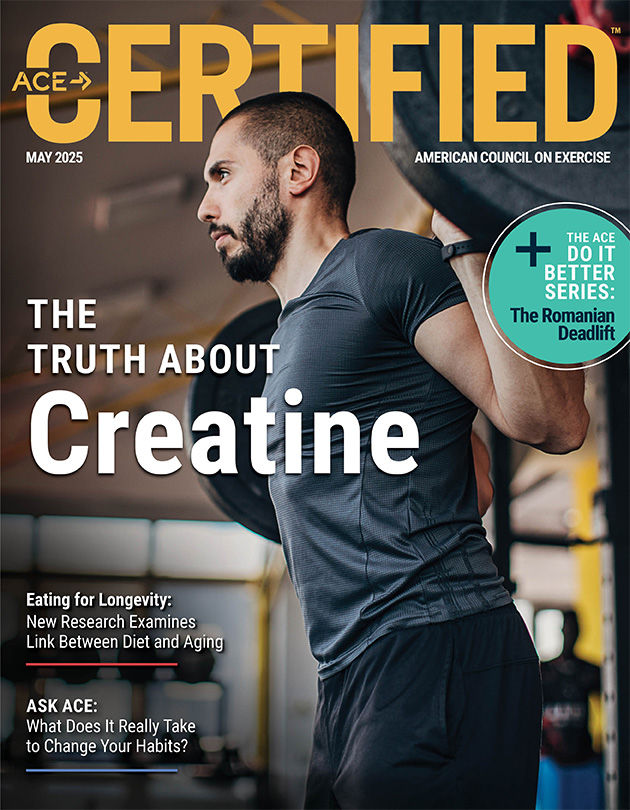
Creatine use among athletes and avid exercisers has a long and somewhat checkered past, including possible Cold War–era use among Russian Olympians that was shrouded in secrecy, as well as a dramatic fall from grace in the late 1990s when a few collegiate athletes’ deaths were erroneously attributed to the supplement (more on this below). Today, creatine supplementation is recognized as an effective and safe way to enhance strength, power and exercise capacity, not to mention several other important benefits that are supported by extensive research. In fact, according to the International Society of Sports Nutrition (ISSN):
“Creatine has become one of the most extensively studied and scientifically validated nutritional ergogenic aids for athletes.”
While selling or even recommending nutritional supplements falls outside the scope of practice for ACE Certified Professionals who do not hold other credentials such as medical doctor or registered dietitian nutritionist, Lance Dalleck, PhD, professor of Exercise and Sport Science at Western Colorado University, explains that “it’s well within our scope of practice to provide good educational resources so that our clients can make informed decisions.” The goal, he says, is to educate clients so that they become better at making science-driven choices instead of relying on information that may be filled with bias.
In that spirit, let’s explore how creatine works in the body, review some of the pervasive myths about creatine and take a deep dive into the evidence-based benefits of this popular supplement.
How Creatine Works
Creatine, whether it’s taken as a supplement or consumed in foods like meat and seafood, is converted into phosphocreatine in the muscles, which helps produce energy in the form of adenosine triphosphate (ATP). During high-intensity exercise and resistance training, ATP is rapidly depleted; creatine helps regenerate ATP, allowing for sustained performance.
Boosting ATP production through creatine supplementation can stimulate muscle growth, enhance recovery and improve performance, especially when coupled with a consistent resistance-training program. In addition, as you’ll read below, studies suggest a wide array of additional benefits.
Busting Some Common Misconceptions
The ISSN position stand on creatine supplementation and exercise quoted above features nine points related to the use of creatine as a nutritional supplement, making it a must-read for anyone who is considering taking creatine or any professional who is seeking more information on the topic. Here are the first three items on that list:
“Creatine monohydrate [the most commonly studied and consumed supplement form of creatine] is the most effective ergogenic nutritional supplement currently available to athletes in terms of increasing high-intensity exercise capacity and lean body mass during training.”
“Creatine monohydrate supplementation is not only safe, but possibly beneficial in regard to preventing injury and/or management of select medical conditions when taken within recommended guidelines.”
“There is no scientific evidence that the short- or long-term use of creatine monohydrate has any detrimental effects on otherwise healthy individuals.”
So, with all of that said about its effectiveness and safety, how is it that creatine use fell out of favor in the late 1990s and why are there so many pervasive myths about its use?
A huge part of the reason is a classic tale of misleading headlines followed by much less publicized corrections. In 1997, three college wrestlers at three different universities died while on crash weight-loss diets. Autopsies found that all three had been taking creatine supplements, which led to widespread and alarming headlines. In response, the U.S. Food and Drug Administration investigated and found that creatine was not a factor in any of the deaths. However, the public’s perception of creatine as dangerous and even deadly had been cemented.
There are also several common myths and misunderstandings about creatine that were widespread during that era and continue to persist. Here, we present each myth, along with evidence that debunks it.
Myth #1: Creatine is an anabolic steroid.
Dr. Dalleck points out that a second factor in creatine’s downfall was that it got caught up in the hype and eventual backlash to Major League Baseball’s steroid era (which lasted from around 1994 to 2004), as prominent and since-disgraced players credited creatine supplementation for their success in an attempt to hide their steroid use. As a result, many people mistakenly thought creatine was a type of anabolic steroid.
While the physiological and performance outcomes of anabolic steroids and creatine can be similar, creatine has a completely different chemical structure and is not an anabolic steroid. Anabolic steroids are classified as drugs and it is illegal to possess or administer them without a physician’s prescription. This is simply not true of creatine.
In fact, Dr. Dalleck highlights that creatine is permitted by governing bodies like the International Olympic Committee (IOC) and National Collegiate Athletic Association (NCAA), which indicates that it’s not only legal, but safe.
Myth #2: Creatine causes kidney damage and renal dysfunction.
Even with more than two decades of research demonstrating no adverse effects of creatine use on kidney health, this myth persists based on a single case study published in 1998 that garnered a lot of attention. However, research indicates that creatine supplementation, when taken in the correct dosage, does not result in kidney damage or renal dysfunction in healthy individuals.
Myth #3: Creatine leads to water retention and bloating.
The most common adverse side effect of creatine supplementation is water retention over the first several days, leading to some initial weight gain. However, evidence shows that it likely does not cause an increase in total body water relative to muscle mass or lead to water retention over the long haul.
Greg Degnan, MD, consultant for medical programming to the Atlantic Coast Athletic Clubs’ Fitness and Wellness app and associate clinical professor of orthopedic surgery at the University of Virginia, explains that creatine pulls water into the muscles, so while the scale may go up slightly at first, your muscles are simply better hydrated, making them stronger and healthier.
Myth #4: Creatine leads to dehydration and muscle cramping.
Much of the support for this idea stems from early guidelines that were based on speculation from creatine users rather than real evidence from well-controlled studies. For example, in a survey of athletes using creatine, 25% reported muscle cramps and 13.5% reported symptoms of dehydration. However, this study failed to control for the use of other substances or the dosage of creatine ingested—and 91% of study participants admitted to exceeding the recommended dose of 5 mg/day.
In another study of college athletes, football players who took creatine were found to have less cramping, fewer heat illnesses or signs of dehydration, reduced muscle tightness and strains, and fewer total injuries. In summary, research does not validate the notion that creatine causes dehydration or muscle cramping.
A Review of the Evidence
So, now we know what creatine doesn’t do, but what does the evidence tell us about the benefits of creatine supplementation? As Dr. Dalleck wrote in Performance and Nutritional Supplements: Myths and Realities, “There is a mountain of scientific literature demonstrating that creatine supplementation increases skeletal muscle mass during exercise training. Moreover, the long-term safety of creatine monohydrate has been well-established.”
The benefits for athletic performance are clear, but as creatine becomes increasingly popular among non-athletes, you’re likely to field some of the following questions from clients:
What are the potential benefits of creatine use as we get older, specifically as it relates to combatting sarcopenia, osteoporosis and frailty?
This is perhaps the most interesting question surrounding creatine use, as the benefits of supplementation run parallel to what people need to counteract many of the effects of aging.
Dr. Degnan explains: “One of the things I have consistently been finding among the patients who come through my medical programming—these are chronically deconditioned and chronically ill patients—is that when you look at their muscle-to-fat ratio and when you look at their lower extremities, we have a baby boomer generation that can’t support its own body weight. It’s frightening and it’s the reason why falls and hip fractures have such a huge impact on our healthcare dollars and the rehab world.”
Sarcopenia, which is defined as the decline of skeletal muscle mass and strength with age, is underappreciated and underdiagnosed, he says, which makes a huge impact on the health of the aging population. Even as the healthcare community has tried to get ahead of conditions like osteoporosis (another age-related condition), it has failed to do the same for sarcopenia.
So, what does this all have to do with creatine? According to Dr. Degnan, creatine supplementation, while tremendously beneficial for older adults, should be initiated well before sarcopenia begins. You can think of this in the same way you might think of osteoporosis. The goal with osteoporosis is to maximize bone mineral density early in life so that you are better positioned to withstand the loss of bone mass as you age—you don’t want to start addressing osteoporosis after it’s already begun to develop.
The same holds true for sarcopenia, and creatine supplementation can be tremendously helpful in developing muscle mass and strength so that people face this inevitable result of aging from a stronger starting point.
Dr. Degnan, who is a member of the ACE Scientific Advisory Panel alongside Dr. Dalleck, uses the metaphor of standing on a mountainside. We all start to go downhill eventually when it comes to sarcopenia, but developing muscular fitness as a younger adult means that an individual will be higher up on that mountainside when the decline begins, which may lead to better health and a better quality of life as they age.
Research into the effectiveness of creatine supplementation on aging muscle and bone provides evidence to support this metaphor. According to the researchers, “Sarcopenia is associated with reduced bone mass and bone strength and may be a contributing factor for the increased risks of falls and fractures often observed in aging adults. It is well established that resistance training is an effective lifestyle intervention for improving aging muscle mass, strength and bone accretion. Accumulating evidence indicates that creatine supplementation, with and without resistance training, has possible anti-sarcopenic… effects. Specifically, creatine supplementation increases aging muscle mass and strength.”
Is creatine beneficial for people who are not resistance training?
The quotation above includes the phrase “with and without resistance training,” which leads to the question of whether resistance training is required to yield the benefits of creatine supplementation. Dr. Degnan explains that older adults who are not resistance training but are just trying to become more active can still benefit from creatine use.
This is particularly true of individuals who have been inactive and may already be seeing the effects of sarcopenia. They are starting at a low point in terms of muscle strength and mass, so starting a walking program or other physical activity to try to rebuild muscle and improve energy production will be helpful. Creatine will help them restore ATP in the cells and allow for better workouts, even if it’s not resistance training.
For a younger population, creatine use without resistance training is likely to be much less beneficial, so it’s typically recommended that creatine supplementation be paired with a resistance-training program.
Is creatine safe for youth or adolescent athletes?
The American Academy of Pediatrics (AAP) advises against creatine use in children and teenagers due to insufficient research with that demographic in terms of its long-term use. The AAP states that, “Until the safety of creatine can be established in adolescents, the use of this product should be discouraged.” In that same study, the AAP acknowledges that creatine prevalence in grades 11 and 12 approaches that reported among collegiate athletes, so this is likely a question you will face if you work with young athletes.
Your position should be that creatine has not been proven safe for this population and that any client under the age of 18 should consult with their pediatrician or orthopedist if they are considering creatine supplementation.
What impact might creatine use have on mental and cognitive health?
A review on the effects of creatine supplementation on cognitive function found that there is evidence that short-term memory and intelligence/reasoning may be improved by creatine use, but that its effects on other cognitive domains remain unclear. It’s important to note that this review focused on healthy individuals and the researchers stated that, “It is imperative that creatine should be tested on patients with dementias or cognitive impairment.”
According to Dr. Dalleck, it's been well known for some time that creatine supplementation is neuroprotective. He explains that because creatine helps the body regenerate ATP to make more energy when there isn’t the presence of oxygen, it makes sense that it would be neuroprotective when there is insufficient blood flow (and therefore oxygen) to the brain as the result of concussion, traumatic brain injury or stroke, for example. The research linking the mechanisms of creatine to hard clinical outcomes is ongoing.
Dr. Degnan explains that a lot of animal studies in this area have shown encouraging results and that researchers are currently looking at creatine use among individuals with amyotrophic lateral sclerosis (ALS), multiple sclerosis and Parkinson’s disease. “They don’t have hard data yet, but they’re seeing encouraging results in terms of addressing some of the neuroendocrine problems,” he says.
What are some of the other evidence-based benefits of creatine use?
Here is a quick rundown of additional benefits that are supported by the research literature:
- Recovery: Creatine helps with muscle glycogen replenishment if taken with carbohydrates. Creatine supplementation/loading has also been shown to reduce muscle damage and soreness following intense exercise.
- Injury prevention and rehabilitation: According to research, creatine users experienced less incidence of cramping, muscle tightness, muscle strains/pulls, noncontact injuries, and total injuries/missed practices than those not taking creatine. Another study reported that individuals taking creatine experienced greater changes in muscle size (+10%) and peak strength (+25%) during the rehabilitation period.
- Prevention of altitude sickness: Studies have shown that creatine supplementation can improve exercise performance at high altitudes, allowing for sustained activity despite the reduced oxygen availability. Dr. Dalleck, who conducts a lot of research in this area in the High Altitude Execise Physiology Program at Western Colorado University, explains that creatine can be beneficial because the hypoxia—that is, the lack of oxygen to the brain tissue—can be partially offset by creatine availability and the ability to create ATP in oxygen-deprived situations.
- Heat tolerance: Findings provide strong evidence that creatine supplementation (with or without glycerol) may serve as an effective nutritional hyperhydration strategy for athletes engaged in intense exercise in hot and humid environments, thereby reducing the risk to heat-related illness.
Final Thoughts
As a health coach or exercise professional, your scope of practice does not allow you to recommend or sell creatine or any other nutritional supplement to your clients. That said, creatine supplementation is likely a hot topic of conversation among your clients, no matter their age, fitness level or goals, and you can assure them that creatine is widely regarded as a safe and effective way to improve performance and stave off the effects of aging. By referring to articles like this one, you can be confident that your answers to client questions are evidence-based and grounded in the latest research. Remember, your role is to educate your clients so that they can make the best decisions for themselves. Ultimately, however, anyone considering taking creatine should talk to their physician or a registered dietitian nutritionist before getting started.
Expand Your Knowledge
Exercise and the Role of Supplements
While supplement companies often claim their products offer dramatic results with no downside, the truth is that there’s a lot of misinformation circulating about supplementation. This makes it critical to understand what the science says about the relationship between nutrition, supplementation, physical activity and exercise. Developed by Rachele Pojednic, PhD, EdM, NBC-HWC, CSCS, and Emily Johnson, MS, RD, this course offers a clear, evidence-based look at supplements, the ways you can determine whether they might be right for you, and how to seek out high-quality information through trusted resources.

Fitness Nutrition Specialist Program
Understanding nutrition takes more than simply knowing what to eat. Knowing how to use behavior change coaching is critical to effectively help clients develop habits that will yield positive results lasting a lifetime. The ACE Fitness Nutrition Specialist Program is designed for health and exercise professionals who want to gain a deeper understanding of nutrition, learn how to help clients implement healthy food choices into their daily routine and understand how to address special nutritional needs for different types of clients, from those simply looking to get healthier to competitive athletes. You'll learn how to guide clients in selecting fresh, nutrient-dense foods, and couple this knowledge with behavior change strategies that will help your clients turn smart choices into long-term habits. As an ACE Fitness Nutrition Specialist, you will be armed with essential behavior change strategies paired with science-backed nutrition information to help your clients become more knowledgeable about their nutrition and develop life-long dietary habits that lead to better health.





 by
by 




